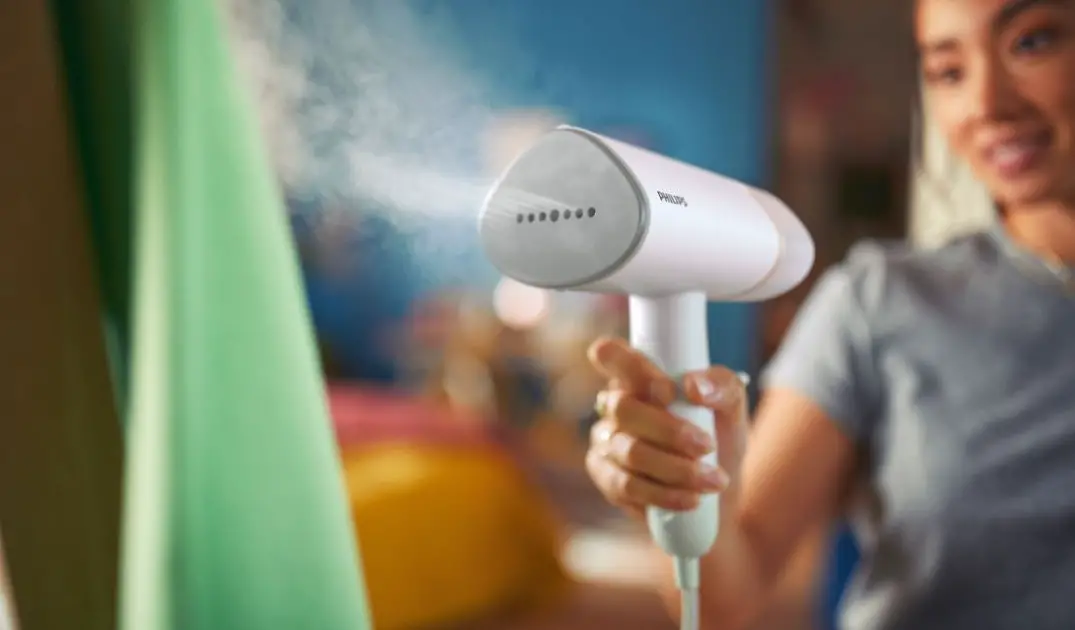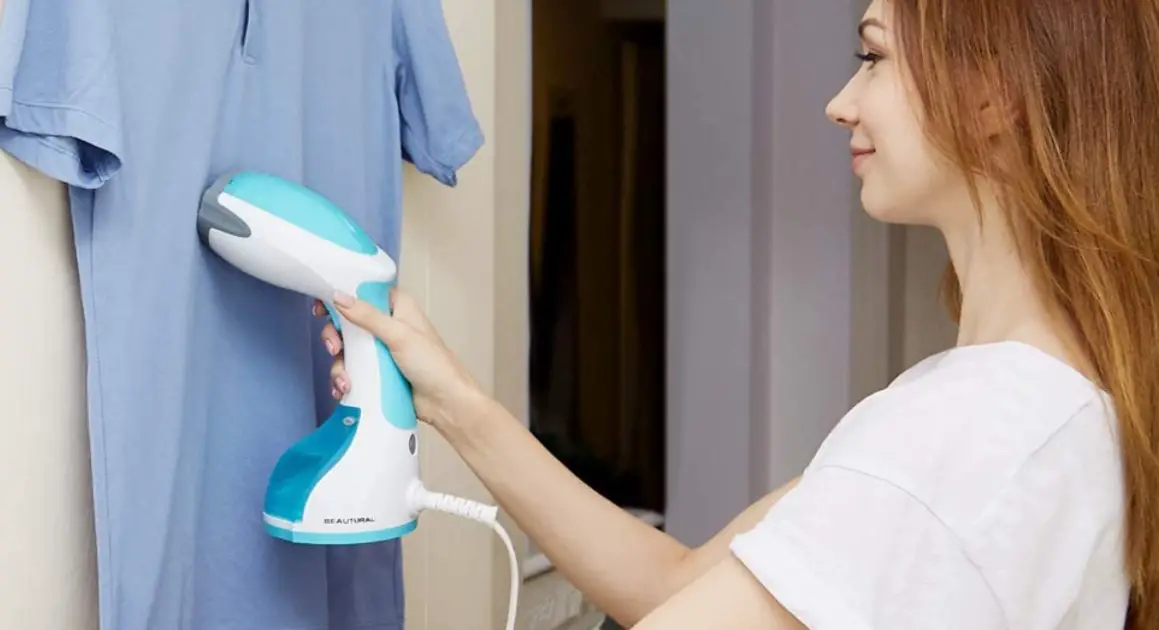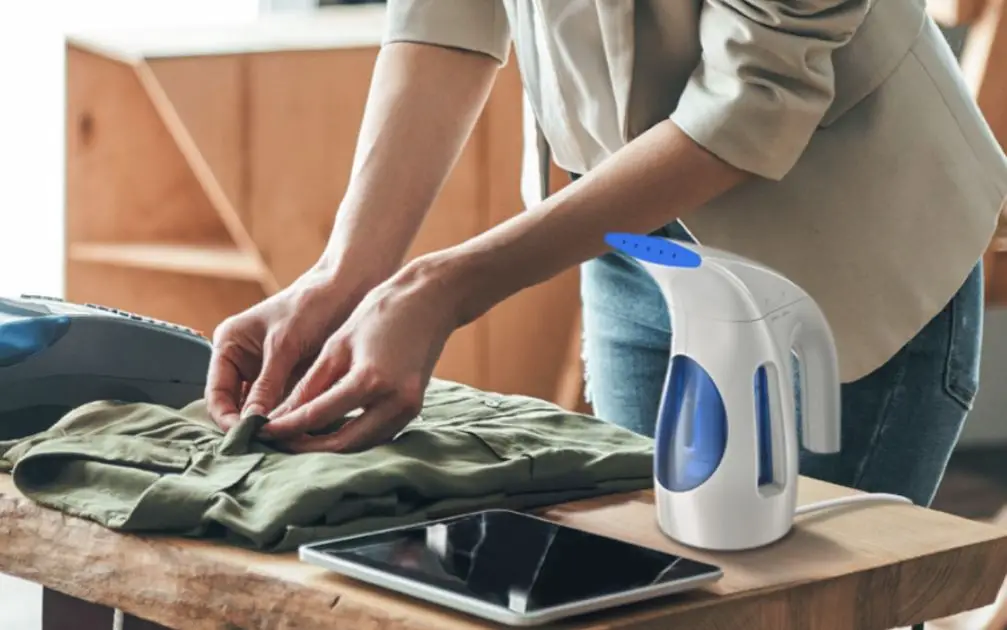Are Handheld Steamers Worth It – Do They Really Work? – Buying Guide

Have you ever accidentally left an iron on your clothes for too long and scorched your favorite shirt or pants?
Do you travel a lot and need a viable ironing alternative? If so then you may be interested in a handheld steamer.
Amazingly, there are a lot of people who still don’t really know what a handheld steamer is and how one could be a big benefit.
So if you are interested in these little gadgets or are simply sick of the old way of getting wrinkles out of your clothes, pay close attention to the following guide.
In it we will be telling you all about handheld steamers including what they are, how they work and how to choose the best one.
If you are going to buy a handheld steamer, you should carefully examine it’s steam settings. You may also want to figure out how much energy it will take to run. Some people may need a model with additional features and brushes.
It may sound like a lot of consideration for such a small appliance but trust us, you will be glad you did your research before making a decision – buyer’s remorse is very real and applies to small purchases too.
But don’t worry, we’ve got your covered. We have all the answers to the questions you have about handheld steamers so let’s take a look!
Do Handheld Steamers Really Work?
The short answer is yes, they do. The long answer is that they work best for light wrinkles and certain fabrics.
The best way to look at a handheld steamer is as a supplemental ironing apparatus – in other words, they shouldn’t be used as your first measure against wrinkles.
If you are semi-responsible with your clothes after they come out of the dryer, a handheld steamer will work fine.
They work best for touch-up drying and for fabrics like silk, polyester, corduroy, velvet or any synthetic fabric.
What can you use a handheld steamer for?
The great thing about a handheld steamer is that it can be used for more than just getting wrinkles out of clothes.
While they are best on synthetic fabrics, you can also use the steam they generate to spot clean drapes, curtains, upholstered furniture, baby cribs, blankets, pet beds and more.
You can get a model with a brush head to help get stains off of these and other surfaces or simply use the steam to loosen the stain and wipe it away by hand.
Steamers are also great for de-wrinkling delicate fabrics that would be damaged with a normal iron.
Check Out The Best Handheld Steamers Here:
Is A Handheld Steamer Worth Buying?

In general, it is a good idea to have this little appliance handy. However, there are a few instances in which it would be especially worth buying a handheld steamer:
- You Travel A Lot – It’s not a very practical option to bring your heavy iron and an ironing along with you when you travel. Handheld steamers are light, compact and don’t require a board or flat surface.
- You Have A Lot of Delicate Fabrics – A handheld steamer doesn’t actually make contact with your clothes. The steam gently relaxes fibers to release the wrinkles which means they are safe for delicate fabrics.
- You Want Better Versatility – You can’t spot clean your furniture, drapes or other surfaces with a traditional iron; but you can with a handheld steamer.
Is steaming clothes better than washing?
Putting your clothes in the washer is the best way to clean and sanitize them. However, it’s better to steam certain fabrics so as to not damage them.
Clothes Steamers Vs Traditional Irons
There are pros and cons on each side. You may ultimately choose to own both. A traditional iron uses a flat plate that is heated up via an internal heating element. The surface is placed against the clothing and the heat loosens up the fabrics.
You apply a bit of force so that the wrinkles get flattened out. Like handheld steamer, you have to plug an iron into a standard electrical outlet and keep a reservoir of water in it.
A traditional iron would be best for anyone with a lot of heavy fabrics while a handheld would be best for travel use.
Iron Pros:
- Good for heavier fabrics like denim and canvas
- You can use an iron to produce pleats and creases
Iron Cons:
- It’s possible to scorch your clothing
- Not viable for traveling
Handheld Steamer Pros:
- Good for cleaning surfaces
- Not likely to damage clothes
Handheld Steamer Cons:
- Can’t make pleats or creases
- Better suited for supplemental de-wrinkling
Handheld Steamer Vs Standing Steamer

Handheld and upright steamers work the same basic way: water is put into a reservoir tank which is then heated by an internal heating element to produce steam which exits the nozzle and de-wrinkles clothes.
As the name implies, handheld steamers are smaller, lighter and more compact. Upright steamers have larger water tanks and a long hose or wand, the end of which has the nozzle.
Upright steamers would be best for home use while handheld steamers are better on the go.
Handheld Steamer Pros:
- More compact and lightweight
- Great for travel use
Handheld Steamer Cons:
- Not as powerful as upright models
- They can’t steam for as long as uprights
Upright Steamer Pros:
- Good for heavier fabrics
- Usually include their own hangers
Upright Steamer Cons:
- They are bigger, bulkier and heavier
- Storage may be an issue
Handheld Steamer Pros
- Great for Vacations – If you want to make sure your clothes stay neat on vacation you may want to pick one of these steamers up.
- Contact-Free – You don’t actually touch the steamer to your clothes so there is much less risk of damaging he fabric.
- Inexpensive – You can get a base model for as little as 16$ but they are usually no more than $60.
Handheld Steamer Cons
- Less Ironing Power – A handheld steamer will be less powerful than both a traditional iron and an upright steamer.
- Time – It may take a handheld steamer longer to get wrinkles out than an iron or an upright model.
- Small Reservoir Tank – Depending on the size of the garment, you may have to refill the tank midway through.
What should I look for in a handheld steamer?
- Brushes – If you want to use your steamer on carpet, furniture and other surfaces, you may want one with brush attachments.
- Steam Settings – Ones with multiple steam settings will be better for de-wrinkling different types of fabrics.
- Heat Up Time – Try to get one that doesn’t take too long to heat up.
- Energy Usage – The average operating power of a steamer is about 1600 watts.
- Accessories & Attachments – Brushes, steaming wands, steaming gloves and even boards may be accessories you need if you plan on using your steamer for more than just clothes.
- Budget – If course, you will want one that fits comfortably within your budget.
Best 5 Brands Of Handheld Steamers

Rowenta X-Cel Handheld Hand Steamer
This steamer has a 6.7 ounce capacity water tank and heats up in as little as 45 seconds. It’s just a hair heavier than 2 pounds so it’s excellent for travel.
It uses a powerful heating element to get produce hot steam that is suitable for a wide variety of fabrics.
Conair® Extreme Steam® GS45 Fabric Steamer
The dual-heat technology means that you won’t have to wait around for very long for this steamer to heat up. It comes from a great, trusted and reliable brand too.
PurSteam Garment Steamer
The PurSteam Garment Steamer has a 9 foot power cord for better mobility and range of motion. It has a 900 watt heating element too so it’s powerful enough for slightly heavier fabrics.
Hilife Steamer
The Hilife Steamer has a 700 watt heating element but on a full tank of water it can run for up to 15 minutes. It’s very compact and great on cotton, wool, linen and even nylon.
It’s also inexpensive so it’s a good option if you aren’t looking to spend a bunch of money on a handheld steamer.
Suyi Handheld Garment Fabric Clothes Steamer
If you are looking for a bargain you can nab this steamer for just around $20. It’s got 12 little steam vents so it provides even de-wrinkling so long as you run it down your garments slowly.
How to Use A Handheld Steam Cleaner

Simply fill the reservoir tank with water, plug it it and set the level of steam you want. While you’re waiting for it to warm up, hang your garment on a door or any overhead support.
Run the steamer over the garment in a downward motion. Repeat until it’s de-wrinkled.
How to Use A Handheld Steam Cleaner on A Couch
Press the button to release the steam onto the upholstery and give the stain or spot a few passes. Then use the hose to vacuum up the moisture.
How to Use A Steam Cleaner on Carpet
It’s best to use a steamer with a microfiber attachment so you can wipe the stain away after you have lifted it with the steam.
Handheld Steamer FAQ’s

Q: Can I steam clean my couch with a clothes steamer?
Yes, you can get light stains out of the upholstery of your couch with a handheld steamer. Just keep in mind that it may not be powerful enough to lift deep-seated or particularly stubborn stains.
Q: Where does the dirt go when steam cleaning?
The dirt doesn’t actually go anywhere. It is simply broken up by the heat of the steam. This makes it much easier to simply wipe the dirt away. After steaming the spot or stain, you will still have to manually wipe it away which should be much easier to do if you have steamed it already.
Q: Does a steamer remove stains?
A steamer will not actually remove stains. All it does is lift the stain and break it up so it’s easier to manually wipe away.
Q: How hot does a handheld steamer get?
The steam that a handheld steamer generates can get as hot as 230 degrees Fahrenheit. This is hot enough to burn skin so be very careful when operating your handheld steamer and keep it out of the hands of your children.
Q: How long do you steam for?
It will depend on the type of fabric. For example, cotton may take longer to steam than synthetic fabric. It will also depend on the size of the garment you are steaming.
Q: What should you not use a handheld steamer on?
The general rule is to avoid using a handheld steamer on anything that can melt. So jackets with iron-on patches may not be good to steam because the steam can melt the adhesive and cause the patch to fall off. Garments with plastic buttons may also get damaged under the steam. Suede is also a material to avoid if you’re using a steamer.
Q: Who will get the most from a handheld steamer?
You should get very good use out of your steamer if you travel a lot for work and need it to iron your garments in hotel rooms and on the go. It would also be a great appliance if you want to be able to spot clean your couches, pillows, blankets and other upholstered surfaces.
Final Thoughts

The thing we like the most about these little handheld devices is that they have a much wider range of use than a traditional iron.
You will still have to take care of your clothes when they come out of the dryer (folding, hanging etc.) but if you do that already, handheld steamers are a great option.
We hope we have shed more light on this often misunderstood appliance and that you check out some of the great steamers we’ve highlighted!


